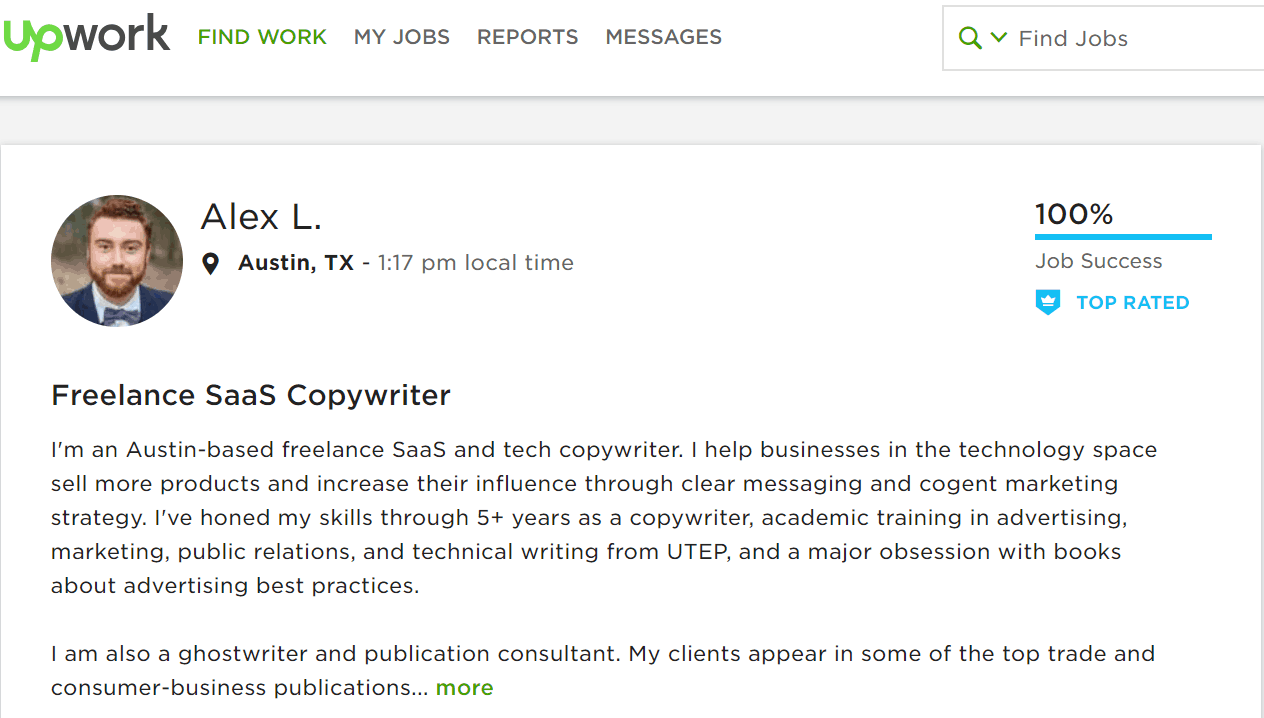I resigned from my last full-time job in spring of 2016. I didn’t have another job lined up and figured that, without a paycheck, I’d have ample incentive to find my next job.
What I didn’t anticipate, however, was that I’d never find that next job. During the first week of my job search, I went to dinner with my friend Aaron, an entrepreneur. I had always been inspired by Aaron’s career and wanted advice about where he thought I should work next.
I already had a list of ideas in mind. Aaron kindly nodded along to my various plans until he finally interrupted me, “You live in a tech-heavy city, why don’t you just write copy for tech companies?”
And like that, my freelancing career was born. The next day, I purchased a book about how to get started as a freelancer, The Well-Fed Writer. In it, Peter Bowerman describes a life that sounds almost too good to be true—flexible work schedule, no boss, the potential to earn the big bucks, fulfilling work, zero dress code, the thrill of running your own business, and so on.
EXCLUSIVE FREE TRAINING: Successful Founders Teach You How to Start and Grow an Online Business
Could it really be that good?
Three years later, I can vouch that for me, freelancing lives up to the hype. There’s a lot to love about it.
But it’s not all rainbows, cash flow, and working in fluffy bathrobes. Especially not at the beginning.
Like learning any new skill, the hardest part of freelancing is getting started. It’s the sink-or-swim phase that separates the swimmers from… well…the others.
I don’t think you can predict whether you’ll love or even be able to sustain a thriving freelance business unless you dive in, head first, and just learn as you go by applying your skills in the real world.
But how do you get started if you’ve never freelanced before?
An expert on this topic is Sabri Suby, a successful consultant who took his business from 0 to $10 million in just four years. Foundr sat down with him to discuss the fine art of how to get started as a freelancer. If you’re considering freelancing, listen to Sabri before you go any further. Then I’ll unpack some of the concepts he brings up, in greater detail.
Assess Your Skills and Experience
At the very core of every freelance business is a defined skill that solves someone else’s problem. “If you don’t have that skill already,” Sabri recommends gaining it by “reading books, buying and doing courses, and getting real world experience.”
Acquiring that skill, and then improving upon it through real-world experience, is the heart of what it takes to be a freelancer.
The skill may be consulting on a certain subject, coding, SEO services, project management, taking photos—you name it. But naming it is the first step.
Determine the skill you are able to sell and then find ways to gain experience applying that skill to help others overcome challenges. Generally, the more experience you have, the more you can charge.
Determine Your Skill-to-Market Fit
Veteran graphic designers will tell you that there’s a big difference between art and design. While an artist seeks to create something meaningful or beautiful, designers exist solely to solve real-world problems using artistic skill.
Both the designer and the artist may use the exact same tools and have equal levels of creativity. The difference is, one applies their skill to create something for for its own sake. The other applies their skills to help businesses overcome a challenge and make money.
Successful freelancers learn to apply their skill toward solving problems, like the designer. This requires first finding a skill-to-market fit.
As I’ve noticed during my three years of freelancing, there are many businesses in need of good copywriters. And from what I can tell, there aren’t enough great copywriters to fill the need.
That’s the demand curve you want to aim for as a freelancer: one that empowers your position at the negotiating table. The last thing you want is to be in an overcrowded race to the bottom.
It’s not about the optics: it’s about selling your skills to companies that desperately need them.
Freelancing for ‘Exposure’
Sabri points out that, contrary to commonly held belief, you don’t have to give your services away for free to begin a freelance business. Once you have the necessary skills, you can begin earning money by applying those skills right away. As he puts it, “When money is exchanged, that’s when something becomes a reality. … If you’re doing things and not getting paid, that’s just a hobby.”
But since the pro bono model is a popular way for new freelancers to gain experience (and how I started my freelance business), I want to give this approach fair mention.
I got my first copywriting experience long before my freelancing career began. As an early twenty-something, I started creating content for a nonprofit in my home town of Fort Myers, Florida.
In all honesty, I didn’t care if the position was paid—I was just blown away that someone wanted to publish my writing on a regular basis. I never stopped to ask if I should be compensated for my time, because I never anticipated that I’d one day turn that experience into a business.
By the time I launched my freelance business, all that pro bono work had culminated into a strong starting portfolio. I believe it made finding my first paying clients much, much simpler. Though, admittedly, I agree with Sabri that free work is seldom necessary for launching a freelance business. It’s just one method of many.
If you don’t have any professional experience using your skills, and want to gain that experience before you charge someone, be choosy about where you give away free work. I recommend volunteering your skills for causes you believe in. This can be anything from a nonprofit organization to your friend’s bootstrapped startup.
The key is, don’t get stuck working for free for too long. Keep in mind the old joke about the artist who died of exposure. You should be paid for your labor. In all honesty, just a few samples of your work is all most business owners need to see to determine if they’re ready to hire you.
Get Out Into the Real World
Whether your first projects are pro bono or paid, the important thing is to get your hands dirty. Books, training courses, and university classes can be invaluable resources for gaining the skills you need to be a good freelancer. But eventually you’ll have to set aside the books to actually start booking.
Sabri points out that there’s only so much you can learn from reading and studying. It’s the “trial and error process that allows you to become a master.”
As you start to search for clients in the real world, Sabri recommends documenting this process. Start recording information about people you worked with who received the best results. What techniques did you use to land these clients? What industry are they in? What made this project unique? Why did this client receive the best results?
These trends can give you clues as to the types of clients and projects that work for you, as well as how to find them. This information can lead you into a profitable niche.
Use this information to continuously refine your processes. Then, with repetition and practice, you’ll become a master at delivering consistently great results within that niche.
Finding Your First Paying Clients
Work can come from almost anywhere. And if you freelance long enough, it just might start coming from everywhere.
But in those early days, before you’re known as an expert and have your sweet spot for finding clients, it can seem like no one hires freelancers. So where do you go to find people who are looking for your skills?
Sabri’s advice about recording where and how you discovered clients will help you continuously hone your process for acquiring clients. But before you can start documenting, you have to land that first project. Here are some common tactics for finding those first clients:
Tell Your Community
Tell your friends and family. Email past colleagues. Shout it from your apartment balcony: “I am starting a freelance business!”
Your personal contacts are often the first ones who will entrust you with paid work. They already know you, which means recommending your work to people they know can feel very fulfilling. Before you start marketing to a bunch of strangers, tell the people you already know that you’re starting to freelance and are looking for work. You never know who might send a project your way.
Use Social Media
I discussed some of my favorite social media marketing strategies in another post recently. So I’ll keep this more surface level.
There are three primary ways to use social media to market your freelance business. Some social media platforms are only good for one or two of these methods, but that’s for you to discover on your own.
- Showcasing through posting: This is perhaps the most obvious way to use social media. Literally you just post about the work you do. You can post samples of your work, blog posts about your ideas, or even just straightforward requests for recommendations.
- Outreach: On many social media websites, there are ways to direct message people or businesses within the platform. In this case, you can use cold outreach to contact potential customers. Of course, you should read about the best practices first—you don’t want to annoy all your potential clients right out of the gate.
- Join communities: Many social media websites have various niche groups. You can use these for networking or connecting with others in your field.
Sign up for Freelancing Websites
In many ways, the internet has revolutionized freelancing. There are now countless websites that connect freelancers with gigs. These services vary in quality, price, and form, so you can select the ones you think work best for your needs. Here are just a handful to try:
- Upwork
- Thumbtack
- Problogger
- PeoplePerHour
- 99Designs
- TaskRabbit
- Fiverr
- Servicescape
Freelance aggregate sites can have a legitimizing effect. Potential customers can read reviews, see your job success rate, and learn about your expertise. But be careful. These sites should be a support for your business—not a crutch.
If you rely too heavily on one of these platforms, then a simple algorithm tweak or uptick to the level of competition can drive your business earnings potential way down.
Find free advertising space
In my first 6 months of freelancing, I landed three great clients by placing ads for free on Craigslist. Obviously, sites like Craigslist can draw a sketchy crowd, and you want to be careful who you work for. However, if you’re vigilant and wise, you may just find some quality clients by posting about your services.
Another form of free advertising is earned media through guest posting. A friend began a photography business a few years ago. One of the first ways he advertised his businesses was by sending samples of his work to people he knew working at local magazines. One magazine paid him for a couple shots and then included his contact information below the photos in their next edition.
Many writers, consultants, or specialists use this same tactic by guest blogging. They pitch article ideas to various publications within their industry. When a publication loves the pitch and commissions the story, the writer gets the opportunity to showcase their writing in front of someone else’s audience. This can be a great way to get new clients. That same publication may have charged the writer thousands of dollars to buy add space. Instead, the writer gets to show off their work for free.
Cold Outreach
Sometimes the easiest way to get new business is simply to reach out to everyone you want to work for, and say so. A friend of mine works for a startup that hired a freelancer who literally knocked on their door to see if they had any writing work they needed to outsource.
At Lewis Commercial Writing, my wife and writing partner, Sarabeth Lewis, has found clients through cold emailing advertising agencies.
If you’re feeling particularly chatty, cold-calling is still a great way to drum up business. And since so few freelancers do it, cold calling can also be a great way to find businesses that no one else is marketing to.
Plug Into the Local Community
Networking, like most business practices, is most efficient with a clear strategy. Instead of attending one-off events without purpose, determine why you want to attend each event. In fact, you should determine the why before you decide which events to attend.
Sarabeth and I briefly lived in Fort Worth, Texas before returning to our home in Austin. Within a few months of moving to Fort Worth, we teamed up with local Dallas freelancers to launch the Dallas chapter of Freelancers Union. The months we spent fostering a community with other freelancers still pay off. Even after we moved back to Austin, freelancers from Dallas and Fort Worth have continued to send relevant referrals our way.
It’s also important to network where your clients gather. While it can be beneficial to network with fellow freelancers, the best places to find work are at conferences within your niche. In our case, Sarabeth and I try to attend local startup/SaaS events, since those account for most of our clients.
Showcasing Your Accomplishments
Now that you’ve got some experience under your belt, you’ll want to showcase your work in a portfolio. Whether its a Google doc or a fancy website, you need something to send to potential clients. They’ll expect to see your work.
Think about your freelancing website as an online brochure. It may seem counterintuitive at first, but don’t focus on yourself as you design your website. Instead, make your clients the focus of the copy and design.
Describe the new reality your clients can expect to enjoy after they contract your services. You can do this several different ways, but the most important thing is to make your customers the hero of the story—and position yourself as their guide.
Social Proof
One of the most important elements to include on your website is social proof. This is how you will show future clients that other business owners have trusted you with similar work. Social proof can be client testimonials, full-blown case studies, or a portfolio page with samples of your work.
As Sabri mentions, this process has two benefits. On one hand, positive feedback from customers will help you grow more confident in your ability to deliver great results, which will empower you to charge more for your work and pursue projects that may have previously felt out of your league.
The second thing social proof offers is confidence for your prospective clients. By displaying evidence of your success on your website in the form of reviews and portfolio pieces, you demonstrate to future clients that you are able to solve their problems (because you’ve solved similar problems in the past!).
Getting Started is the Hardest Part
Learning how to get started as a freelancer is exciting. You’re at the cusp of learning many new skills, overcoming incredible challenges, and solving big problems for real people and businesses.
As Sabri mentioned, this is how you “refine your skill sets, build confidence, build a body of work, and go out there and start landing clients.”
The key is to play the long game. While the early days may come with a lot of confusion or feelings of impostor syndrome, be patient with yourself. You’ll never become a powerhouse expert in your field if you don’t take the initiative to start learning and practicing today.
And keep in mind, just because a skill comes naturally to you doesn’t mean you shouldn’t charge a premium. What comes easily for you might be a nightmare for the business owner who’s willing to pay you.
Determine the skill you’d like to provide, learn where that skill is needed in the market, and then start solving problems for paying customers. Before you know it, you’ll have a booming freelance business and wonder why you didn’t get started even sooner.
What skill are you trying to promote as a freelancer? Tell me about your expertise in the comments.
EXCLUSIVE FREE TRAINING: Successful Founders Teach You How to Start and Grow an Online Business

















